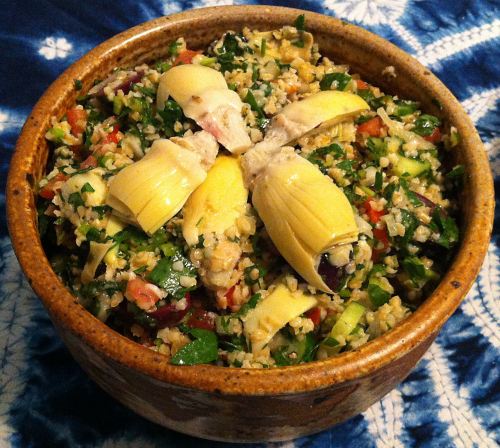Adapted from a Recipe Lion recipe
I came upon a recipe for Iraqi barbecued chicken and I wanted some Iraqi side dishes to go with it. I found a recipe for Iraqi pickled vegetables and another for Iraqi tabbouleh. Just about every country in the Middle East has a variation of this salad of grain, parsley and mint dressed with lemon and oil. Other additions to the basic elements can be tomatoes, cucumbers, red or green onions, olives, and for the Iraqi version pickled artichoke.

Karl’s Iraqi Tabbouleh
It is the proportions of the ingredients and the additions that make each country’s variation its own. In Lebanese tabbouleh there is more parsley and mint and less bulgur. Turkish tabbouleh uses more bulgur than greens. Iraqi Tabbouleh splits the difference with an equal balance of greens and bulgur.
Bulgur is made of wheat groats that have been parboils and then dried. It comes in four grades, from fine (#1) to very course (#4). While you can re-hydrate them with hot stock more quickly, it is more common to use cold water and time. After soaking one cup of bulgur turns into two cups of fluffy rice-like grains.
Karl’s Iraqi Tabbouleh
Ingredients
1 cup bulgur wheat, medium grade #2
½ cup olive oil
½ cup fresh lemon juice
1 tsp. salt
½ tsp. freshly ground black pepper
1 medium onion, finely chopped
5 green onions, finely chopped
1½ cup flat-leafed parsley, finely chopped
½ cup fresh mint, finely chopped
1 medium tomatoes, seeded and chopped
1 Persian cucumber, quartered lengthwise and sliced
½ cup Kalamata olives, halved
½ cup marinated artichoke hearts, chopped
Directions
1. Place the bulgur in a medium-sized bowl and cover it with cold water.
2. Let the grain stand for 2-3 hours.
3. In a small, lidded jar, mix the olive oil, lemon juice, salt, and pepper.
4. Shake the dressing well and set it aside.
5. Squeeze out as much of the liquid as you can and spread the bulgur out to dry on a clean kitchen towel laid over a lipped baking tray.
Tip: You can strain the water and bulgur through cheese cloth, but I simply take handfuls and squeeze them over a large strainer—to catch any falling bits.
Note: You want your bulgur to be “mama bear,” not too wet or too dry.
6. Transfer the bulgur to a large bowl.
7. Add the onions and scallions and working them in with your hands.
Tip: As the onions shed their moisture, you want the bulgur to absorb it evenly. Clean hands are still the best tool for the job.
8. Add the parsley, mint, tomatoes, cucumber, olives, and artichoke bits.
Note: Reserve one whole artichoke to quarter and use as a garnish.
9. Pour half of the dressing over the salad and toss to mix.
Note: Reserve the rest of the dressing to serve on the side at the table for diners who would like to add more.
10. Cover with plastic wrap and refrigerate the tabbouleh for at least 2 hours before serving.
11. Transfer to a serving bowl and garnish with the remaining artichoke heart.
Tip: This salad keeps well and is better the second day. However. if you plan to make this the day before, you may consider adding the tomatoes just before serving—as they tend to get a bit mealy over time.
Note: If you wish, you may serve a scoop of tabbouleh in a leaf of butter or romaine lettuce.

Pingback: Karl’s Djaj Bil-Bahar Il-Asfar (Iraqi Yellow Spice-Rubbed Chicken) | Jabberwocky Stew
Pingback: Karl’s Tabbouleh | Jabberwocky Stew
Pingback: Karl’s Moorish Tabbouleh | Jabberwocky Stew
This sounds really good! I have never made Iraqi food, but am excited to try this!